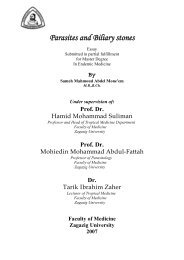J.'.~"";i'
J.'.~"";i'
J.'.~"";i'
You also want an ePaper? Increase the reach of your titles
YUMPU automatically turns print PDFs into web optimized ePapers that Google loves.
Pathogenesis of pre- eclampsia<br />
Review ofLiterature<br />
The exact nature ofthe primary event causing pre-eclampsia is not<br />
known. However, one of the initial events in this disease is abnormal<br />
placentation, in which the main feature is inadequate trophoblastic<br />
invasion ofthe maternal spiral arterioles. In normal pregnancy the wall of<br />
the spiral arteries is invaded by trophoblastic cells and transformed into<br />
large, tortuous channels that carry a large amount of blood to the<br />
intervillous space and are resistant to the effects of vasmotor agents.<br />
These physiologic changes are restricted in-patients with pre-eclampsia<br />
(Brosens, 1977).<br />
The anatomic and physiologic disruption ofnormal placentation is<br />
thought to lead to altered endothelial cell function and multiple organ<br />
damage (Shankil and Sibai ,1989). .<br />
The majority of pregnant women with chronic hypertension have<br />
essential hypertension. Rarely, the hypertension results from chronic<br />
renal disease, renal artery stenosis, pheochromocytoma,<br />
hyperaldosteronism, or other casuses (Lindheimer and Katz, 1985).<br />
In pre-eclampsia, absence of normal stimulation of the renin<br />
angiotensin system, despite hypovolaemia, and increased vasucular<br />
sensitivity to angiotensin II and norepinephrine can be explained by a<br />
biologic dominance of TxA2 over prostacyclin. A reduction in urinary<br />
excretion of prostacyclin metabolites precedes the development of<br />
clinical disease, whereas TXA2 biosynthesis is increased in pre-eclampsia.<br />
Increased TxA2 production in pre-eclampsia is largely derived from<br />
platelets and the placenta. Placental prostacyclin production is reduced.<br />
(Dekker and Sibai, 1998).<br />
9
















